Japanese travel experiences (W. Woess)
This text was written after a 5 weeks' journey to Japan
in summer 2007.
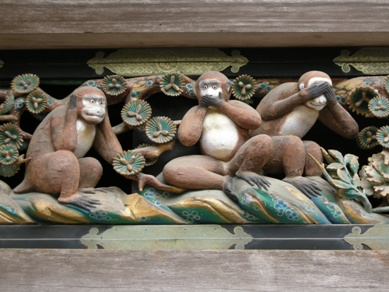
Famous monkeys at the Tokugawa shrine in Nikko
Guidebook and other informations
I did not buy the Lonely Plante guide of Japan because its latest issue
was not as recent as the one of the guide that I chose. Fortunately,
I did take along some copies from the Lonely Planet guide. At equal weight,
the latter turns out to be better organized and contain more info.
On the website of the Japan National Tourist Organisation
http://www.jnto.go.jp one can find useful material. In particular, for many
places or regions of interest one can download pdf-files of 4-6 pages
with clear outlines of the essential information.
For daily weather forecast, I used
http://www.jma.go.jp/jma/indexe.html
and
http://www.weather-forecast.com/countries/101/locations.
The second was in general slightly more optimistic than the first, the truth
is in between.
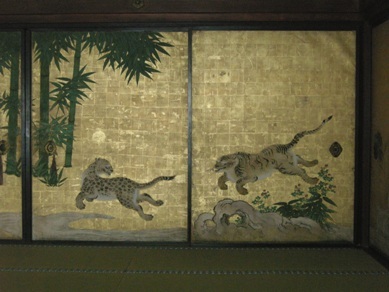
Tigers in Nanzen-ji temple, Kyoto
Internet
In many hotels and inns, one has free internet access by wlan or lan.
So taking a laptop along is useful for daily planning of the trip.
Language
It is true that apart from Kyoto, and unless you are entering a university
campus, it is hard to find people who speak English. It just needs your
patience, if you made no efforts to learn some your host country's language.
In some cases, it also seems that people are too shy to use the
amount of English that they learned.
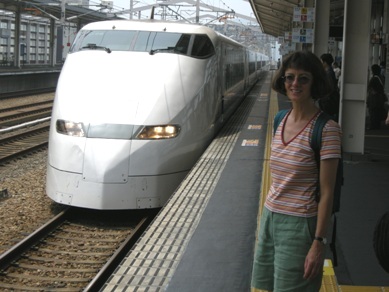
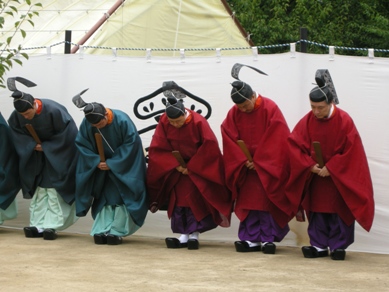
Shinkansen train / Ceremony at Kitano Temangu shrine, Kyoto
Travelling by train and bus
On the whole, travelling in Japan is easy, probably easier than for a foreigner
in Europe. In particular, the train system is very well organized, and
one finds all station's names in English. At each station, not only can
one see its name, but also the name of the previous and the next stop.
Using the Japan rail pass is very convenient, but one has to buy it
(i.e., the exchange coupon) before entering the country. It is certainly
worth its money !
At Shinkansen stations one can get a small booklet with all the Shinkansen
timetables, plus some selected additional ones (airport trains, other main
lines). One can also find it on the webpage of Japan Rail (JR),
http://www.japanrail.com.
For specific timetable search on smaller train lines, etc., one can use
http://grace.hyperdia.com/cgi-english/hyperWeb.cgi.
At each bigger train station, there are lugagge lockers (not at the small
unmanned stations of local lines, of course).
Travelling overland by bus is not as easy, as far as English names of the stops,
readable timetables, etc. are concerned. In large bus terminals in front
of train stations, etc., it is sometimes hard to find out from which
place your bus will leave.
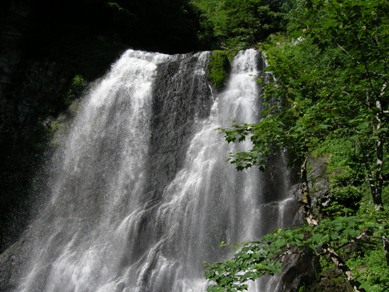
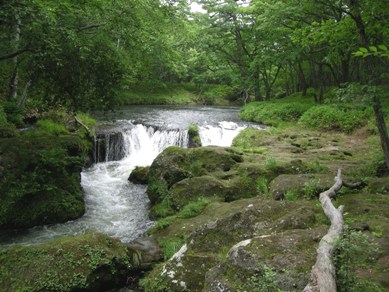
Goshikigahara Waterfalls in the Takayama area / Chuzenji-ko - Yumoto Hike in Nikko NP
Accomodation
All our guidebooks advertise the ryokans of the Japanese Welcome Inn group
as a kind of ``true style'' accomodation while travelling in Japan.
Ryokans are inns with some or several rooms where one sleeps on a futon
on the tatami mat - covered floor. Besides this, the room will
contain a TV, maybe a telephone, a small table 50 cm high with two cushions
to sit on the gound. There are rules about (not) wearing shoes.
Toilets and baths are common use. In particular,
there is a common bath with a big tub (small pool) full of hot water
("onsen") where one can relax after having thoroughly washed oneself outside
the pool. This is the Japanese
variant of Scandinavian sauna. The most desirable case is to have true hot
sprimg thermal water in that pool or tub. In traditional
Ryokans there are spearate ones for men and women, but in the Welcome Inn
ones that I saw, you can use it privately and close the door. In those cases,
sometimes you have to reserve a half hour "onsen" use in advance (half
hour is certainly enough). The Welcome Inn Ryokans are in several respects
well adapted to the needs of Western tourists. One can reserve by internet
or email, i.e., one does not need to overcome the language difficulties
on the phone. The owners, even if the do not speak English well, are
used to comunicating with foreigners. They can help you to reserve at the next
place. Usually, there is Internet connection, there are coin laundries, and
you meet other foreign tourists. On the other hand, I hardly ever saw a
Japanese traveller in one of those Welcome Inn ryokans. They are westernized
to a good amount while still trying to maintain some of the tradition.
I would say that those in smaller places are good, but those in big towns
may be less nice. We did not like the one in Kyoto, for example.
In the countryside there are many ryokans with true thermal onsen baths
and mostly without foreign guests, where Japanese families go on vacation; they
are different. I had a discussion with Japanese colleagues, who say that
in former times, the downtown ryokans would be typically used by businessmen
on business trips, but now these customers are lost because they go to
the business hotels, which do not cost too much more. So trying to attract
Western tourists may be an attempt to assure survival for those ryokans in
bigger cities.
All bigger cities have those business hotels with common standards,
many single and some double rooms with bed and small bathroom, TV, phone,
small fridge, tea boiling facility, internet connection. They are not much
more expensive than the ryokans. Breakfast costs additional 1000 Yen typically,
but it may be better to have breakfast elsewhere.
The advantage of those business hotels is that we are used to the room style.
The disadvantage may be that they are all big and anonymous concrete
buildings with a few 100 rooms.
Direct booking may be more expensive than via the web page
http://travel.rakuten.co.jp/en.
However, the English version seems to contain much less than the
Japanese one. My Japanese colleagues are registered for this website, and
it is very useful for booking accomodation all over Japan at good prices.
What now follows are experiences and descriptions from several specific places.
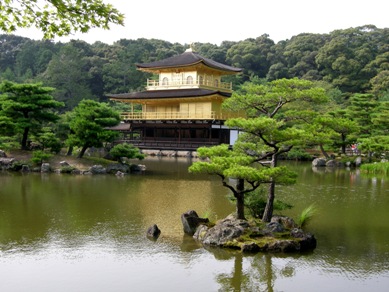
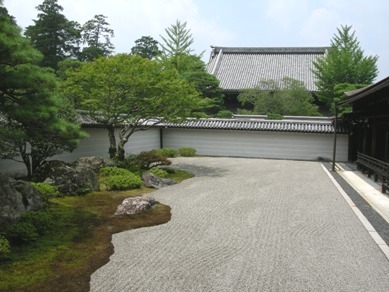
Kyoto temples Kinkaku-ji and Nanzen-ji
Kyoto
There are many sources for sightseeing hints. Accomodation: the Welcome Inn
Ryokans are all close to the station. The only reason to stay in this part of
town may be because it is close to the station. Most of the many sights
are in the parts of the citiy that are close to the hills delimiting
Kyoto to the East, North and West. In those areas, it is also a bit cooler that
in the downtown and station area. After a few Welcome Inn days, I moved
to Casa Carinho Bead and Breakfast
http://www.gotokandk.com/casa.html, which I found in one of the guidebooks.
Very suitable for me (5 minutes walking distance from Kyoto Univ.), a
traditional Japanese house with slightly spartanic, but nice Japanese style
rooms, the owner is Canadian and his wife Austrian.
Public transport in Kyoto is efficient (a dense bus net with a clear
map that you get in all tourist infos, and convenient 500 Yen day passes)
and inefficient (much slower than transport in other cities) at the same time.
(There are also two subway lines and some local trains, all belonging
to different companies.)
If it is hot, one may appreciate a rest in one of the air-conditioned buses
while slowly travelling from one of the many wonderful sights to another.
Around Kyoto there are nice hikes, see Lonely Planet "Hiking in Japan".
I liked Takao (NW, on the bus map), with 2 very nice temples (a 3rd one less
interesting) and a nice trail to Kyotaki along a river in a valley (gorge)
where one can even swim. From there, I also climbed up Mt. Atago-San,
one of the higher peaks close to town. From Kyotaki, another bus goes back
to Kyoto.
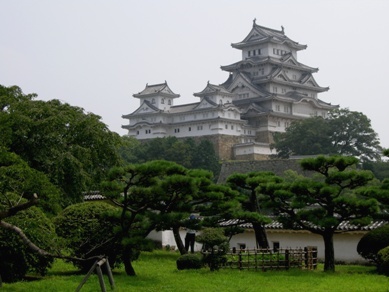
Himeji castle
Himeji
This town has the best preserved castle in Japan. It is very reasonable
to do this as a half day trip from Kyoto. From the Himeji Shinkansen
station it takes 15 minutes walking to the castle grounds. The visit of the
castle takes at most 2 hours. Then back to the station, one can buy lunch before
boarding and recovering from the heat in the air conditioned train back
to Kyoto.
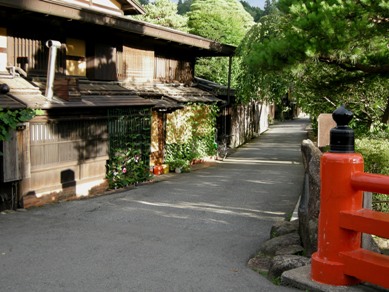
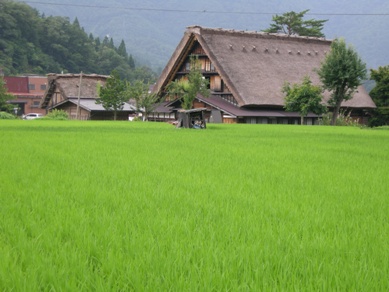
Takayama / Shirakawa-go
Takayama
is a smaller town in the mountains 2 train hours north of Nagoya and is worth a relaxed
stay. It is touristic, but not in an exaggerated way (such as e.g. Hakone).
There are a few very nice old style streets in the center, a walking trail
that visits a series of temples and the remnants of the castle, and a few
further sights. Also very nice is the open air Hida folk museum slightly outside
of twon (SW), which gathers different types of old houses from the region,
set up in a carefully maintained little village, instructive and pleasant.
By bus, one can undertake day trips to several places in the high Japanese
Alps, or to Shirakawa-go, a world heritage village with many
straw-roofed old houses (bus service from Takayama is very slow, the place is
a bit over-touristic).
Accomodation: we followed a hint and did not go to the Welcome Inn place, but
to Minshuku Kuwataniya
http://www.kuwataniya.com/english/english.htm,
a very nice family-run pension comparable
to a Ryokan, with mostly Japanese families as their guests.
Warmly recommended ! They also have "Western style" rooms, and free bycicles at
their guest's disposal.
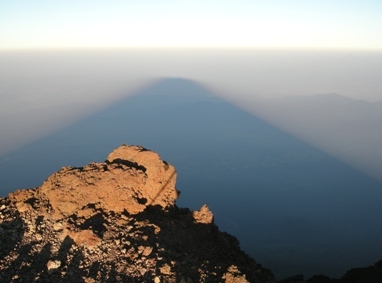
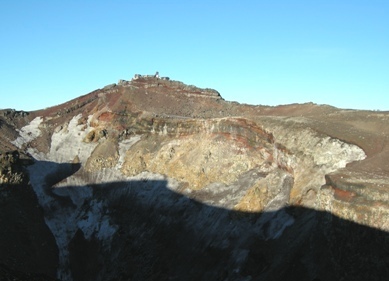
Shade of Mt. Fuji in the Morning sun / Mt. Fuji peak and crater
Climbing Mt. Fuji
In addition to the above two links for weather forecasts, I used the following
for the weather on top of the mountain.
http://www.snow-forecast.com/resorts/Mount-Fuji.0to3top.shtml.
It is worth while to wait for good weather. I had glorious weather and was
accordingly happy. Friends who had had cloudy weather were much less enthousiastic,
and so is T. Wheeler's somewhat badly-mooded report in Lonely Planet
"Hiking in Japan".
Tradition wants to climb overnight, in order to see sunrise from the top.
This also has the advantage of beeing cooler than in the sun. Also, the
likelihood to have now or only few clouds is higher in the morning than later in
the day.
There are four climbing, resp. descending routes. Gotemba (longest) and
Subashiri trails are best for descending, Yoshida and Fujinomiya (shortest)
best for climbing. It seems that most people choose the Yoshida trail,
which has the advantage that if one does not make it in time to the top,
one still can see the sunrise because the trail is on the Eastern slope.
For the rest, I believe the Fujinomya trail is better: slightly less corwded,
a little less steep in the final part, and relatively broad. The latter is
useful,
because the trails are crowded by inexperienced hikers who walk too fast but then
have to pause too often: one will find space for overtaking. When I
was already heading down Subashiri, I saw a long line of people queuing on
Yoshida trail still trying to get to the top in the rapicly increasing heat, but
all had to adapt their pace to the slowest of them.
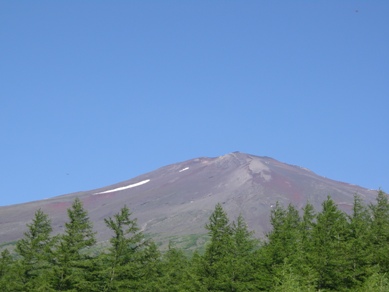
Mount Fuji
It is very reasonable to climb and descend on different routes. In that case
one can leave the luggage in a locker at the train station where one
takes the bus to the selected 5th station starting point (Gotemba, Mishima, or
Fuji stations). I started from Mishima (Shinkansen station). There are only 4 buses per
day going to Fujinomiya 5th station, the last one at 17.30 (Summer 2007). The
bus trip takes 2 hours. The bus stop is at the south exit from the Station;
there is also an
info booth where one can get a return ticket for the bus: it allows you also
to take a bus down from another fifth station, and the overall price (3000 Yen)
is only slighlty more than the one-way fare.
I took Subashiri trail to descend, bus to Gotemba, then local train (southbound)
back to Mishima (change at Numazu).
One starts out from slightly above sea level, bus to an altitude of 2400m, and
then hikes upt to 3780m. Hiking itself is easy, and good sport shoes can
suffice, but even experienced hikers may feel the fast ascent above 3000m.
So if one is ready to spend 5000 Yen to rest for a couple of hours (say, from
9pm to 2am) in a dormitory with 50-80 or more other persons, then one can stay at - say -
the 8th station (3200m on Fujinomiya trail), in order to adapt to the height
and have a rest. I started from 5th station at 6pm, arrived at 8th station
at 8.20pm, had a rest (no real sleep) until 2am, getting started 30min before
the "wake up call" for the other sleepers.
Upon reaching the crater rim from Fujinomiya trail, it may still be dark,
and one may miss the sharp left turn to reach the highest peak with the
observatory: the trail passes just between the huts at the point where one
reaches the rim.
On top one will be very happy to have plenty of warm clothes. Around the crater
rim on all sides of the mountain there will e a few thousand people, almost all
Japanese, waiting for sunrise. Most of them seem to prefer to stay close to the huts where
the trails reach the crater rim. On the highest peak, I met at most 30-40 other
people.
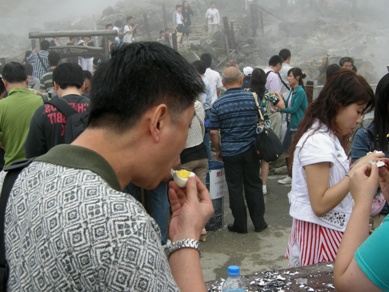
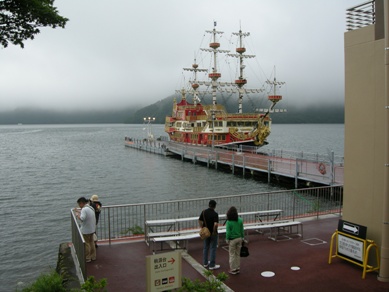
Volcanic egg eating at Owakudani /Pirate ship on lake Ashi in Hakone
Hakone
This is a popular place Southwest of Tokyo, north of Mt. Fuji, steep hills,
Onsen baths and lake Ashi in what is an ancient, extinct volcano.
With good weather, one is supposed to have nice views of Mt. Fuji.
However, it is touristic in an exaggerated Disneyland-like manner, with "Pirate"
ships cruising the lake, a cable car in order to reach Owakudani,a volcanic place
with fumaroles that
smell of sulphur and where the main activity of all tourists is
to eat hot eggs boiled in thermal water from the mountain (a much nicer
spot of this type, almost deserted, is in Pozzuoli north of Napoli, Italy),
etc. etc.
Hakone is a place where - trying to translate from Hesse - tourists from
the country of the child-people may like to go. There is a Welcome Inn ryokan
plus attached youth hostel with Western tourists only; they have a nice outdoor
Onsen bath with hot thermal water. (One has to reserve in the morning for the
coming evening's bath, but in our case someone - the landlady I believe - exchanged
the reservations, thus adding to our frustration.)
In this case, I really blame the guide books which are unable or unwilling to
convey the difference between the type of tourism that one finds in
such a spot as opposed to other places such as Takayama or Nikko.
However, like for Mt. Fuji, the appreciation my also depend on the
weather (very cloudy when we visited).
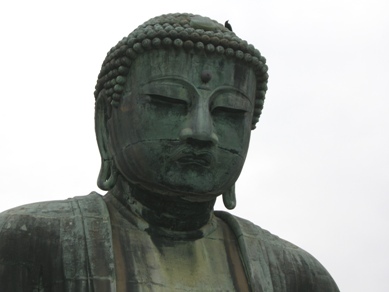
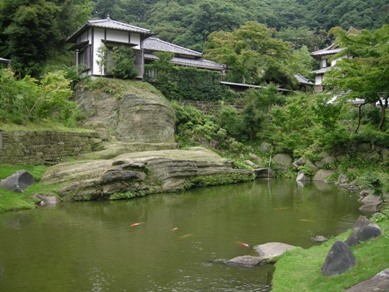
Buddha statue and Zen temple in Kamakura
Kamakura
is a lively town on the Sea south of Tokyo, Japan's capital some 700 years ago.
On can easiliy commute between here and Tokyo. The beach is relatively ugly,
but the town is pleasant and has several very interesting sights, among which
a giant Buddha statue (Daibutsu) and the particularly impressive Engaku-ji
Zen temple, one of the most important ones in the country.
We stayed in a very convenient and comfortable small hotel ..... , which is
very hard to find, because there are no English signs. (Ask until someone
happens to know the place.) (No internet.)
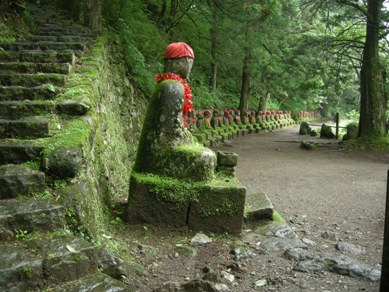
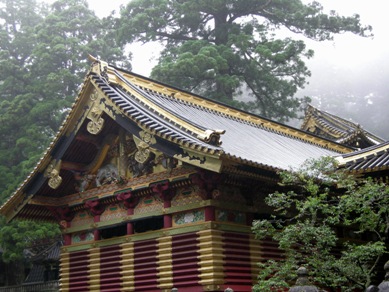
Buddha parade/ Tokugawa shrine area in Nikko
Nikko
left us very impressed. Even though built for rather nasty military
dictators of their time, the Tokugawa shrine and adjancent shrines
and temples are outstanding. Japanese "Baroque", not as sober style as
most other temples and shrines in the country, very refined with
many many little details.
The "Turtle Inn" ryokan
http://www.turtle-nikko.com/ from
the Welcome Inn group is one of the nice and kind ones. Most tourists come
for day visits from Tokyo, evenings appeared quite deserted. There is a
nice and simple little restaurant run by two elderly ladies that specializes
in feeding Western tourists with Japanese food, on the right hand side when walking down the
main street from the sacred bridge, very close.
Also, have a walk beyond the "Turtle Inn". Following the river, there is a place
with a few hundred typical Buddha statues with red caps and shirts standing
in a line facing the river. Above in the wood, there is an old graveyard.
There are frequent bus services
uphill from Nikko to the National park and Lake Chuzenji and beyond
to the little lake Yumoto. Further back along
lake Chuzen-ji it is less foggy in case of rainy weather than close to the famous
Kegon falls. We had a really beautiful and very easy hike from Ryuzu falls
to the Yumoto lake falls through wonderful marshland scenery. This walk may be
continued along the little lake, or extended to a 2day-hike as
recommended by "Hiking in Japan".
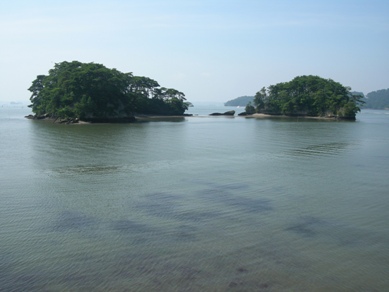
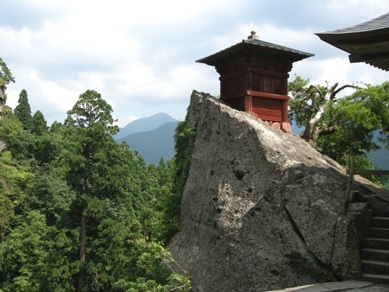
Matsushima islands / Yamadera
Sendai, Matsushima and Yamadera
Sendai itself is not of great sightseeing interest, but it can serve as a
good base point for excursions to various interesting places,
such as Hiraizumi (see below), Matsushima or Yamadera.
Matsushima and Yamadera can by visited as two half-day excursions from Sendai.
Matsushima is to the East, claimed to
be one of the three most famous seaside sights of Japan. With good weather
it is not so bad. There is another impressive temple, and the nature park on the
island NE of the station that you reach by crossing a red pedestrian bridge,
is nice, shady and green and offers nice views on the bay with the many little
islands. I would not have wanted to take one of the crowded boat cruises
of the bay.
Yamadera, 40 min by train to the West, is a temple area in a rather spectacular
rocky mountain scenery, on top of a steep slope with many stone steps in
the shade of cedar trees. Basho was here and dedicated his most famous
Haiku to this place at a time when it was still a quiet spot.
No more quiet, but nevertheless to be recommended.
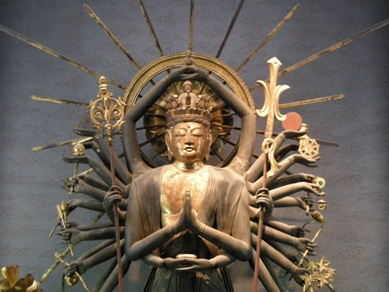
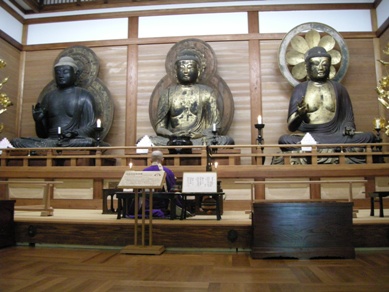
Some treasures of Chuson-ji temple at Hiraizumi
Hiraizumi
This is a small town in Tohoku, between Sendai and Morioka. One can take the
Shinkansen to Ichinoseki, then local train on the JR Tohoku line or
the bus in front of Ichinoseki station (20 min trip).
The Chuson-ji temple area is not only nicely situated on a hill amidst
hight cedar trees, but it houses outstanding art - in particular, the Golden
Hall, a shrine from the 12th century with refined golden decorations,
which is a national treasure and alone worth the visit.
The other temple at Hiraizumi, Motsu-ji, is not as impressive.
Some of the accomodation (a ryokan and a minshuku) mentioned in the
Lonely Planet Guide haven been closed. I stayed at Ohsawa Onsen Ryokan,
tel. 0191-46-2059, fax 0191-46-3146, a relatively
big house from the 1960ies or 70ies with spacious rooms and very good food
(dinner and breakfast)
included in the price. It is about 20 min walking distance from the station,
but the owners are ready to pick you up, resp., bring you to the station. (They asked
slightly too much for bycicle rental, but in view of the positive rest, it was
acceptable.)
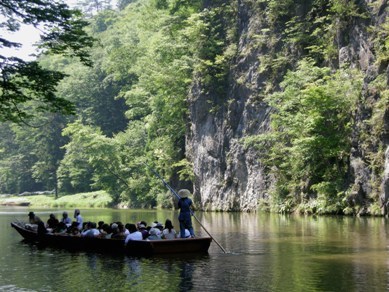
Geibikei gorge excursion boat
Returning to Ichinoseki, it is a 30-40min train or bus ride to the East
to reach Geibikei-kyo, an impressive little gorge with high rock walls
where one can take a boat ride together with other tourists. (Here, once more,
the guidebooks did not care to outline that one can enter the gorge only by
boat - I expected to be able to hike.) At he end, you are let off the
boat and can have a short, but nice walk. I continued for a few minutes beyond
the last touristic spot and took a cool bath in the river, and there was
nobody - as if there was an invisible wall to stop any individual
initiative of the (99.5 % Japanese) tourists.
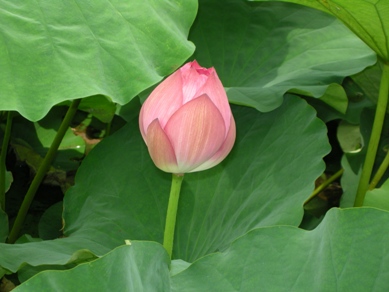
Lotus blossom in Kamakura
Last modified on August 18, 2007. Corrections of misspellings on
May 3, 2010.


























